How to Make Regular Expression Run Again
Everything you need to know almost Regular Expressions

After reading this article you volition have a solid agreement of what regular expressions are, what they tin practise, and what they tin can't practise.
Yous'll be able to estimate when to use them and — more than importantly — when not to.
Let's beginning at the start.
What is a Regular Expression?
On an abstract level a regular expression, regex for short, is a shorthand representation for a set. A ready of strings.
Say we have a list of all valid nada codes. Instead of keeping that long and unwieldy list around, it's often more practical to have a short and precise pattern that completely describes that ready. Whenever you want to check whether a cord is a valid zip code, yous can lucifer information technology against the pattern. Yous'll get a true or false consequence indicating whether the string belongs to the ready of goose egg codes the regex pattern represents.
Let'south expand on the set of zip codes. A listing of zip codes is finite, consists of rather short strings, and is not particularly challenging computationally.
What about the set of strings that stop in .csv? Tin can be quite useful when looking for data files. This gear up is infinite. You can't make a list upwards front. And the only way to test for membership is to go to the end of the cord and compare the last four characters. Regular expressions are a fashion of encoding such patterns in a standardized way.
The following is a regular expression blueprint that represents our gear up of strings ending in .csv
^.*\.csv$
Permit'due south leave the mechanics of this particular pattern aside, and expect at practicalities: a regex engine can test a pattern against an input string to see if it matches. The to a higher place pattern matches foo.csv, but does not match bar.txt or my_csv_file.
Before you use regular expressions in your lawmaking, you can test them using an online regex evaluator, and experiment with a friendly UI.
I like regex101.com: yous can option the flavor of the regex engine, and patterns are nicely decomposed for you lot, and so you get a expert understanding of what your design really does. Regex patterns can be cryptic.
I'd recommend y'all open up regex101.com in another window or tab and experiment with the examples presented in this article interactively. You'll get a much better experience for regex patterns this style, I promise.
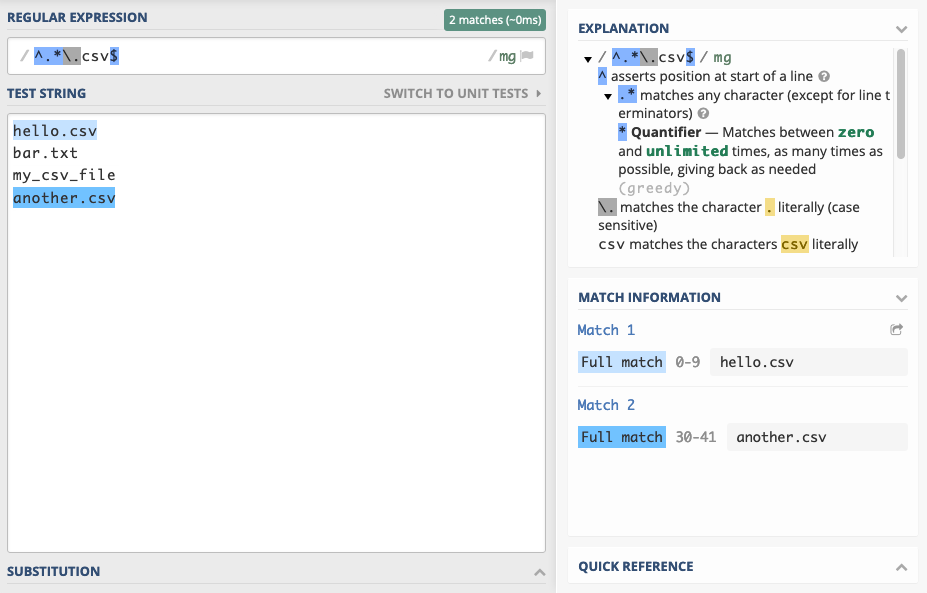
What are Regular Expressions used for?
Regular expressions are useful in any scenario that benefits from full or partial pattern matches on strings. These are some common use cases:
- verify the structure of strings
- extract substrings form structured strings
- search / replace / rearrange parts of the string
- split up a string into tokens
All of these come upwards regularly when doing data grooming work.
The Building Blocks of a Regular Expression
A regular expression pattern is synthetic from distinct building blocks. It may contain literals, graphic symbol classes, boundary matchers, quantifiers, groups and the OR operator.
Permit's dive in and look at some examples.
Literals
The most basic building block in a regular expression is a grapheme a.thou.a. literal. Most characters in a regex pattern do not have a special meaning, they simply match themselves. Consider the post-obit pattern:
I am a harmless regex blueprint
None of the characters in this design has special pregnant. Thus each graphic symbol of the design matches itself. Therefore there is simply one string that matches this pattern, and it is identical to the blueprint string itself.
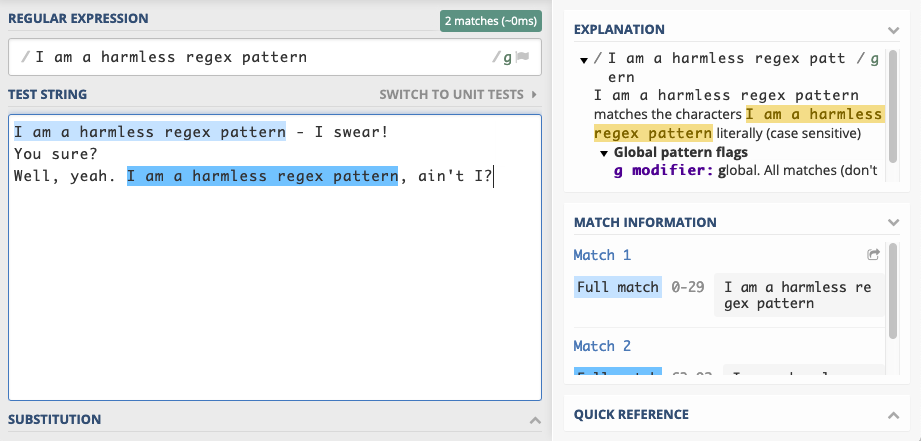
Escaping Literal Characters
What are the characters that do have special pregnant? The following list shows characters that take special meaning in a regular expression. They must exist escaped past a backslash if they are meant to correspond themselves.
Consider the following pattern:
\+21\.5
The pattern consists of literals only — the + has special pregnant and has been escaped, and so has the .— and thus the pattern matches only one string: +21.5

Matching non-printable Characters
Sometimes it's necessary to refer to some non-printable character similar the tab character ⇥ or a newline ↩
It'south best to employ the proper escape sequences for them:
If y'all need to match a line intermission, they unremarkably come in i of two flavors:
-
\noftentimes referred to equally the unix-style newline -
\r\noften referred to as the windows-manner newline
To catch both possibilities you lot can match on \r?\due north which means: optional \r followed by \northward

Matching any Unicode Character
Sometimes you have to friction match characters that are best expressed by using their Unicode index. Sometimes a graphic symbol simply cannot be typed— like control characters such every bit ASCII NUL, ESC, VT etc.
Sometimes your programming linguistic communication simply does non support putting certain characters into patterns. Characters outside the BMP, such as 𝄞 or emojis are frequently not supported verbatim.
In many regex engines — such as Java, JavaScript, Python, and Cherry-red — you lot can use the \uHexIndex escape syntax to friction match any character by its Unicode index. Say we want to match the symbol for natural numbers: ℕ - U+2115
The pattern to match this character is: \u2115
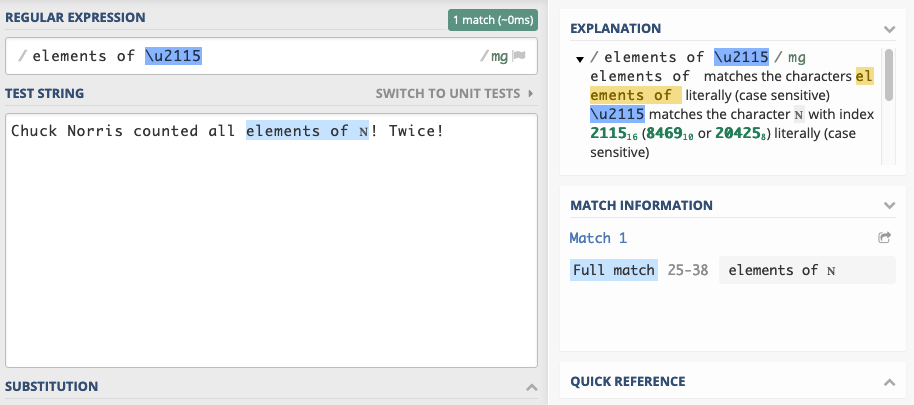
Other engines often provide an equivalent escape syntax. In Go, you would utilise \x{2115} to friction match ℕ
Unicode back up and escape syntax varies across engines. If you program on matching technical symbols, musical symbols, or emojis — especially outside the BMP — cheque the documentation of the regex engine you use to be certain of adequate support for your employ-case.
Escaping Parts of a Pattern
Sometimes a blueprint requires consecutive characters to exist escaped every bit literals. Say it's supposed to match the following string: +???+
The blueprint would await similar this:
\+\?\?\?\+
The need to escape every character every bit literal makes it harder to read and to understand.
Depending on your regex engine, at that place might exist a way to start and finish a literal section in your blueprint. Check your docs. In Java and Perl sequences of characters that should be interpreted literally tin can be enclosed past \Q and \Due east. The post-obit pattern is equivalent to the to a higher place:
\Q+???+\Due east
Escaping parts of a pattern can also be useful if it is synthetic from parts, some of which are to be interpreted literally, like user-supplied search words.
If your regex engine does not have this feature, the ecosystem ofttimes provides a office to escape all characters with special meaning from a design string, such as lodash escapeRegExp.
The OR Operator
The pipe character | is the selection operator. It matches alternatives. Suppose a pattern should match the strings i and 2
The post-obit pattern does the play a trick on:
1|2
The patterns left and right of the operator are the allowed alternatives.
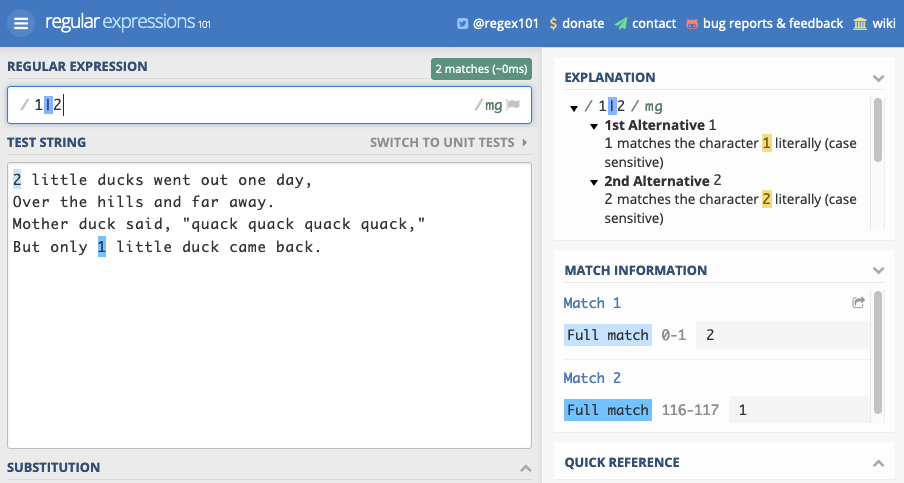
The post-obit pattern matches William Turner and Bill Turner
William Turner|Bill Turner
The second role of the alternatives is consistently Turner. Would be convenient to put the alternatives William and Bill up front, and mention Turner merely once. The following pattern does that:
(William|Bill) Turner
It looks more readable. It also introduces a new concept: Groups.
Groups
Y'all can group sub-patterns in sections enclosed in round brackets. They group the contained expressions into a single unit. Grouping parts of a pattern has several uses:
- simplify regex notation, making intent clerer
- utilise quantifiers to sub-expressions
- extract sub-strings matching a group
- replace sub-strings matching a group
Let's expect at a regex with a grouping:(William|Neb) Turner
Groups are sometimes referred to as "capturing groups" because in case of a friction match, each grouping's matched sub-string is captured, and is available for extraction.
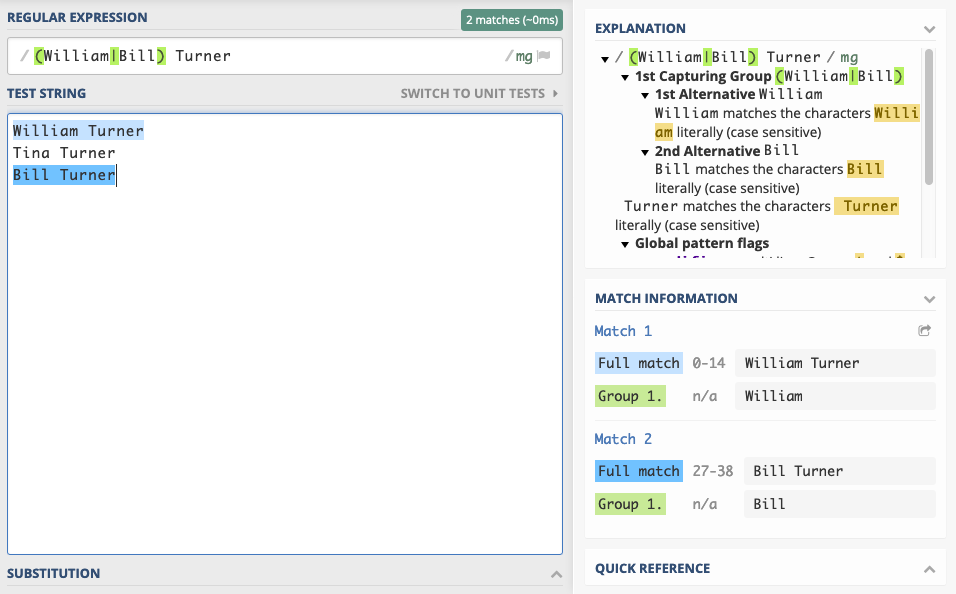
How captured groups are made available depends on the API yous utilize. In JavaScript, calling "my string".match(/pattern/) returns an array of matches. The outset item is the entire matched cord and subsequent items are the sub-strings matching design groups in guild of advent in the pattern.
Example: Chess Notation
Consider a string identifying a chess lath field. Fields on a chess board can exist identified every bit A1-A8 for the start column, B1-B8 for the second cavalcade and and then on until H1-H8 for the last column. Suppose a string containing this notation should be validated and the components (the letter and the digit) extracted using capture groups. The following regular expression would do that.
(A|B|C|D|E|F|G|H)(i|2|3|4|5|six|7|viii)
While the above regular expression is valid and does the chore, it is somewhat clunky. This one works just as well, and it is a fleck more than concise:
([A-H])([i-8])
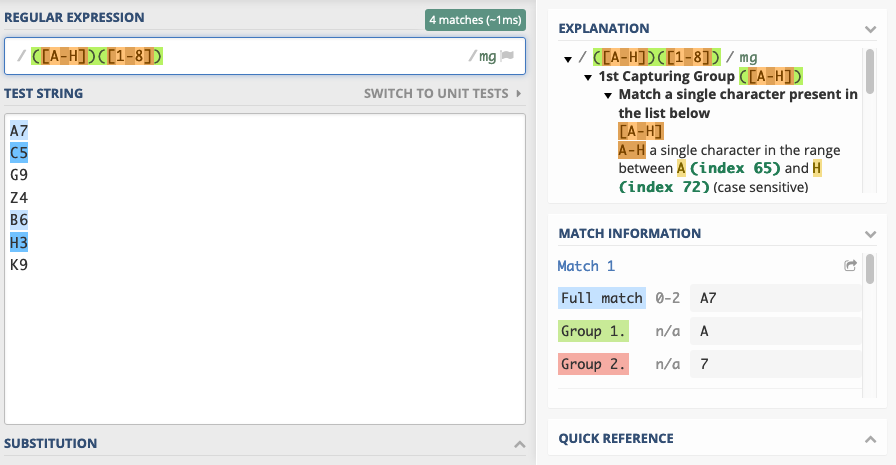
This certain looks more concise. Only it introduces a new concept: Character Classes.
Character Classes
Character classes are used to ascertain a ready of allowed characters. The set of allowed characters is put in square brackets, and each allowed character is listed. The character class [abcdef] is equivalent to (a|b|c|d|due east|f). Since the form contains alternatives, it matches exactly one grapheme.
The blueprint [ab][cd] matches exactly 4 strings ac, ad, bc, and bd. Information technology does not friction match ab, the beginning character matches, but the second character must be either c or d .
Suppose a blueprint should match a ii digit code. A blueprint to friction match this could look similar this:
[0123456789][0123456789]
This pattern matches all 100 2 digit strings in the range from 00 to 99.
Ranges
Information technology is oft irksome and error-prone to listing all possible characters in a character course. Consecutive characters can be included in a character form as ranges using the dash operator: [0-9][0-9]
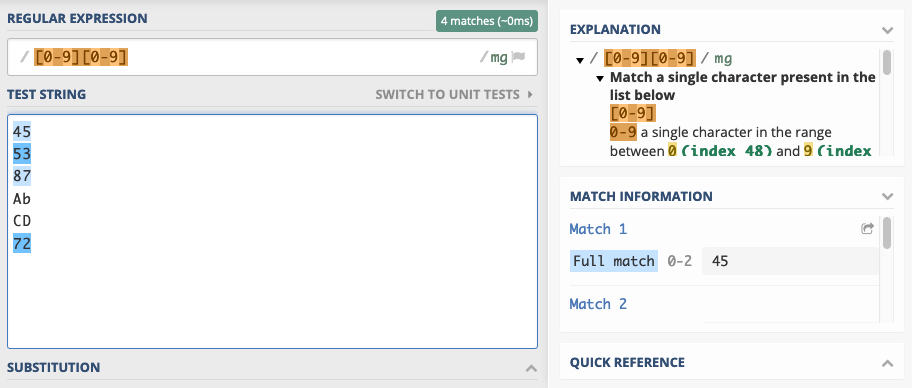
Characters are ordered past a numeric alphabetize— in 2019 that is nigh ever the Unicode index. If you're working with numbers, Latin characters and basic punctuation, y'all can instead await at the much smaller historical subset of Unicode: ASCII.
The digits zero through ix are encoded sequentially through code-points: U+0030 for 0 to code point U+0039 for 9, so a character set of [0–9] is a valid range.
Lower case and upper instance messages of the Latin alphabet are encoded consecutively also, so character classes for alphabetic characters are often seen as well. The post-obit graphic symbol set up matches any lower case Latin grapheme:
[a-z]
You tin can define multiple ranges within the same character form. The following graphic symbol form matches all lower case and upper example Latin characters:
[A-Za-z]
You lot might get the impression that the higher up pattern could be abbreviated to:
[A-z]
That is a valid character course, but it matches not merely A-Z and a-z, it also matches all characters defined between Z and a, such as [, \, and ^.
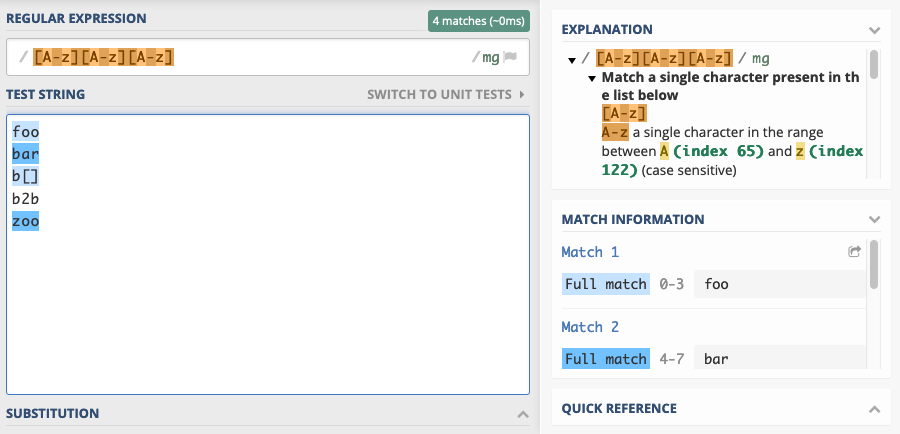
If you're vehement your hair out cursing the stupidity of the people who defined ASCII and introduce this mind-boggling discontinuity, hold your horses for a flake. ASCII was divers at a fourth dimension where computing chapters was much more precious than today.
Look at
A hex: 0x41 bin: 0100 0001anda hex: 0x61 bin: 0110 0001How do you lot catechumen between upper and lower case? You lot flip one scrap. That is true for the unabridged alphabet. ASCII is optimized to simplify example conversion. The people defining ASCII were very thoughtful. Some desirable qualities had to exist sacrificed for others. You're welcome.
Y'all might wonder how to put the - graphic symbol into a graphic symbol course. After all, it is used to define ranges. Well-nigh engines interpret the - character literally if placed every bit the commencement or last character in the course: [-+0–9] or [+0–ix-]. Some few engines require escaping with a backslash: [\-+0–nine]
Negations
Sometimes it's useful to define a grapheme class that matches well-nigh characters, except for a few defined exceptions. If a character class definition begins with a ^, the prepare of listed characters is inverted. As an instance, the post-obit form allows any character as long as it'south neither a digit nor an underscore.
[^0-9_]

Please note that the ^ character is interpreted as a literal if it is not the first character of the course, every bit in [f^o], and that it is a boundary matcher if used exterior grapheme classes.
Predefined Character Classes
Some grapheme classes are used so frequently that in that location are shorthand notations defined for them. Consider the character class [0–9]. It matches any digit grapheme and is used and then often that in that location is a mnemonic notation for it: \d.
The following list shows grapheme classes with most common autograph notations, likely to exist supported past any regex engine you use.
Almost engines come with a comprehensive list of predefined character classes matching sure blocks or categories of the Unicode standard, punctuation, specific alphabets, etc. These additional character classes are often specific to the engine at hand, and not very portable.
The Dot Graphic symbol Form
The most ubiquitous predefined character course is the dot, and it deserves a pocket-size section on its own. Information technology matches any character except for line terminators like \r and \n.
The following blueprint matches whatsoever three character string ending with a lower instance x:
..x

In practice the dot is frequently used to create "anything might go in hither" sections in a blueprint. It is frequently combined with a quantifier and .* is used to match "anything" or "don't intendance" sections.

Please note that the . character loses its special meaning, when used within a grapheme class. The character class [.,] simply matches two characters, the dot and the comma.
Depending on the regex engine you use you may exist able to set the dotAll execution flag in which instance . will match anything including line terminators.
Boundary Matchers
Boundary matchers — also known as "anchors" — practice non match a character as such, they match a purlieus. They friction match the positions between characters, if you lot will. The most common anchors are ^ and $. They match the outset and end of a line respectively. The following table shows the most commonly supported anchors.
Anchoring to Beginnings and Endings
Consider a search operation for digits on a multi-line text. The blueprint [0–9] finds every digit in the text, no affair where it is located. The blueprint ^[0–nine] finds every digit that is the first graphic symbol on a line.

The same idea applies to line endings with $.

The \A and \Z or \z anchors are useful matching multi-line strings. They anchor to the beginning and end of the entire input. The upper case \Z variant is tolerant of abaft newlines and matches just before that, finer discarding any trailing newline in the match.
The \A and \Z anchors are supported by near mainstream regex engines, with the notable exception of JavaScript.
Suppose the requirement is to check whether a text is a two-line record specifying a chess position. This is what the input strings looks like:
Column: F
Row: 7 The following pattern matches the to a higher place structure:
\AColumn: [A-H]\r?\nRow: [1-8]\Z

Whole Word Matches
The \b anchor matches the edge of whatsoever alphanumeric sequence. This is useful if y'all want to do "whole word" matches. The following pattern looks for a standalone upper case I.
\bI\b
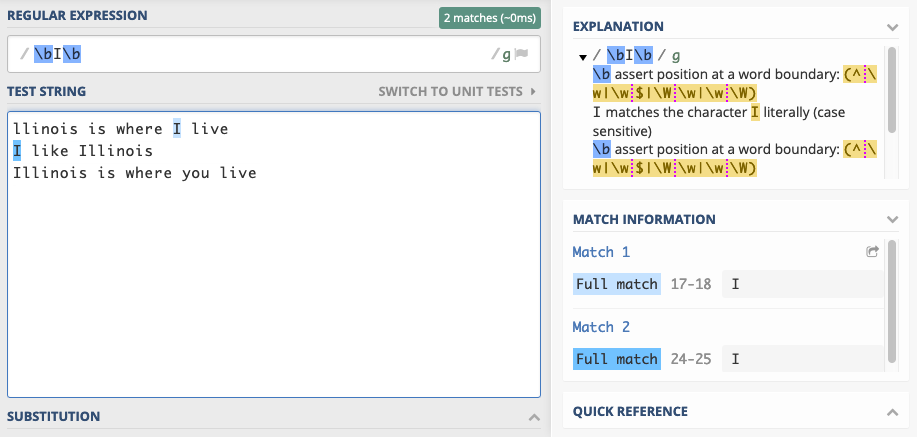
The design does non friction match the showtime letter of Illinois because there is no word boundary to the right. The next letter is a word letter — divers past the character class \w as [a-zA-Z0–9_] —and not a non-word letter, which would institute a boundary.
Permit's supersede Illinois with I!linois. The assertion betoken is not a word character, and thus constitutes a boundary.
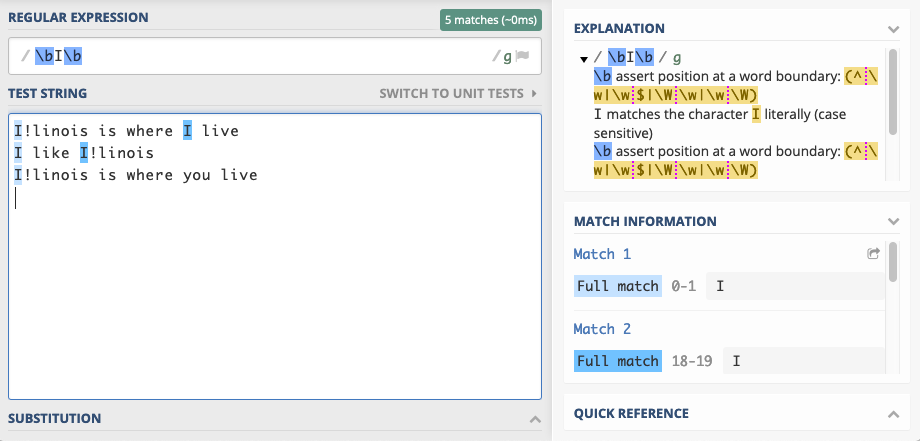
Misc Anchors
The somewhat esoteric non-word boundary \B is the negation of \b. It matches any position that is not matched by \b. It matches every position between characters within white infinite and alphanumeric sequences.
Some regex engines support the \G boundary matcher. It is useful when using regular expressions programmatically, and a pattern is applied repeatedly to a string, trying to find design all matches in a loop. It anchors to the position of the concluding match found.
Quantifiers
Any literal or character grouping matches the occurrence of exactly one graphic symbol. The pattern [0–nine][0–ix] matches exactly 2 digits. Quantifiers assist specifying the expected number of matches of a pattern. They are notated using curly braces. The following is equivalent to [0–9][0–9]
[0-nine]{2}
The bones notation tin can be extended to provide upper and lower premises. Say information technology'southward necessary to match between 2 and six digits. The verbal number varies, just information technology must be between two and half dozen. The following annotation does that:
[0-9]{2,6}
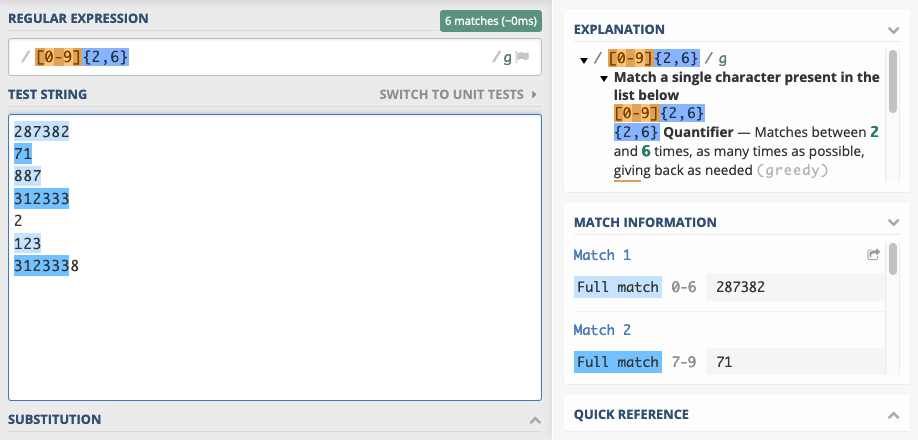
The upper bound is optional, if omitted any number of occurrences equal to or greater than the lower leap is acceptable. The following sample matches two or more consecutive digits.
[0-9]{2,}
There are some predefined shorthands for common quantifiers that are very frequently used in practice.
The ? quantifier
The ? quantifier is equivalent to {0, one}, which means: optional unmarried occurrence. The preceding pattern may not friction match, or match once.
Permit'southward detect integers, optionally prefixed with a plus or minus sign: [-+]?\d{one,}

The + quantifier
The + quantifier is equivalent to {1,}, which means: at to the lowest degree one occurrence.
We can change our integer matching pattern from in a higher place to be more than idiomatic by replacing {ane,} with +and we get:[-+]?\d+

The * quantifier
The * quantifier is equivalent to {0,}, which means: nothing or more occurrences. Y'all'll run into it very often in conjunction with the dot as .*, which means: whatsoever character don't intendance how often.
Let'southward match an comma separated list of integers. Whitespace between entries is not allowed, and at to the lowest degree i integer must be nowadays:\d+(,\d+)*
Nosotros're matching an integer followed past any number of groups containing a comma followed by an integer.

Greedy by Default
Suppose the requirement is to lucifer the domain part from a http URL in a capture group. The post-obit seems similar a expert thought: match the protocol, then capture the domain, and then an optional path. The idea translates roughly to this:
http://(.*)/?
If yous're using an engine that uses
/regex/notation like JavaScript, y'all have to escape the forward slashes:http:\/\/(.*)\/?.*
It matches the protocol, captures what comes afterwards the protocol as domain and it allows for an optional slash and some capricious text after that, which would be the resource path.
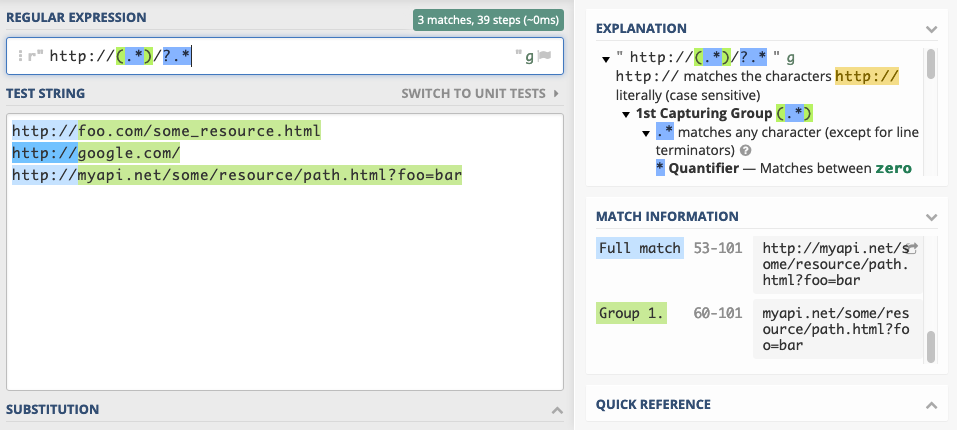
Strangely enough, the following is captured by the grouping given some input strings:
The results are somewhat surprising, as the blueprint was designed to capture the domain function but, but it seems to exist capturing everything till the end of the URL.
This happens because each quantifier encountered in the pattern tries to lucifer as much of the cord as possible. The quantifiers are called greedy for this reason.
Permit'southward cheque the of matching behaviour of: http://(.*)/?.*
The greedy * in the capturing grouping is the offset encountered quantifier. The . character course it applies to matches any character, and so the quantifier extends to the end of the cord. Thus the capture grouping captures everything. Merely wait, you say, there'south the /?.* part at the finish. Well, yeah, and information technology matches what's left of the string — nothing, a.k.a the empty string — perfectly. The slash is optional, and is followed by zero or more than characters. The empty string fits. The unabridged pattern matches just fine.
Alternatives to Greedy Matching
Greedy is the default, just non the just flavor of quantifiers. Each quantifier has a reluctant version, that matches the to the lowest degree possible amount of characters. The greedy versions of the quantifiers are converted to reluctant versions by appending a ? to them.
The following tabular array gives the notations for all quantifiers.
The quanfier{n} is equvalent in both greedy and reluctant versions. For the others the number of matched characters may vary. Let's revisit the example from in a higher place and change the capture group to match as little as possible, in the hopes of getting the domain proper noun captured properly.
http://(.*?)/?.*

Using this pattern, nothing — more than precisely the empty string — is captured by the grouping. Why is that? The capture group at present captures as lilliputian as possible: nothing. The (.*?) captures nothing, the /? matches nil, and the .* matches the entirety of what's left of the string. So again, this blueprint does non work as intended.
So far the capture group matches too little or besides much. Allow's revert back to the greedy quantifier, only disallow the slash character in the domain name, and also crave that the domain name exist at to the lowest degree 1 character long.
http://([^/]+)/?.*
This pattern greedily captures i or more non slash characters afterward the protocol as the domain, and if finally any optional slash occurs it may be followed past any number of characters in the path.
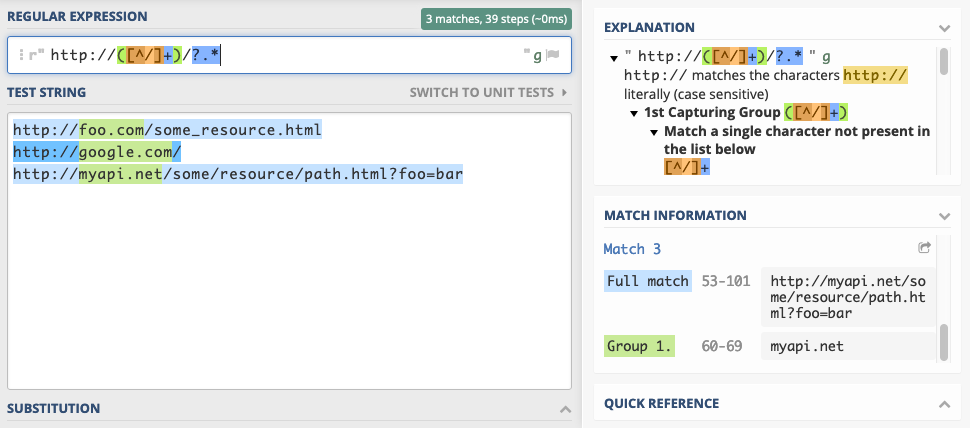
Quantifier Performance
Both greedy and reluctant quantifiers imply some runtime overhead. If only a few such quantifiers are nowadays, there are no problems. Merely if mutliple nested groups are each quantified as greedy or reluctant, determining the longest or shortest possible matches is a nontrivial operation that implies running back and forth on the input string adjusting the length of each quantifier's lucifer to determine whether the expression as a whole matches.
Pathological cases of catastrophic backtracking may occur. If functioning or malicious input is a concern, it's best to prefer reluctant quantifiers and too accept a await at a 3rd kind of quantifiers: possessive quantifiers.
Possessive Quantifiers: Never Giving Back
Possessive quantifiers, if supported by your engine, act much like greedy quantifiers, with the distinction that they do not support backtracking. They try to friction match every bit many characters as possible, and in one case they practise, they never yield whatever matched characters to adapt possible matches for any other parts of the pattern.
They are notated by appending a + to the base greedy quantifier.
They are a fast performing version of "greedy-like" quantifiers, which makes them a adept option for performance sensitive operations.
Let's wait at them in the PHP engine. Offset, let'south look at simple greedy matches. Let'southward match some digits, followed past a nine: ([0–9]+)9
Matched against the input cord: 123456789 the greedy quantifier will start match the entire input, then give dorsum the nine, so the residue of the pattern has a take a chance to friction match.
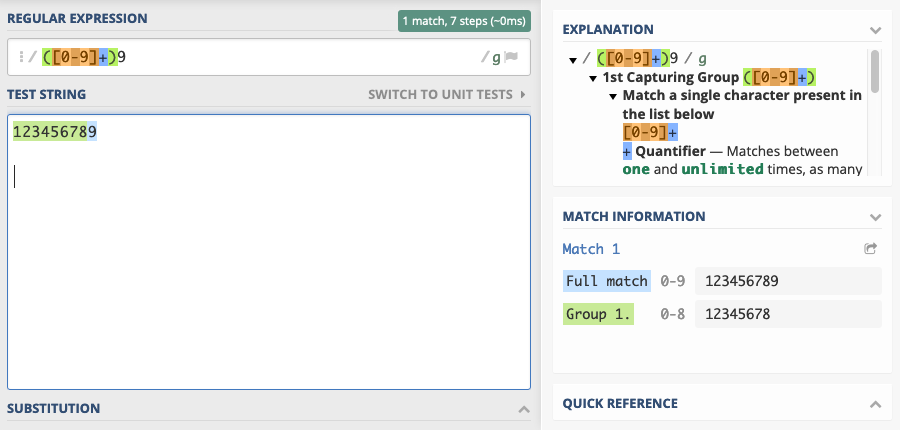
At present, when nosotros replace the greedy with the possessive quantifier, it will match the unabridged input, then refuse to give back the nine to avert backtracking, and that volition cause the entire pattern to not match at all.
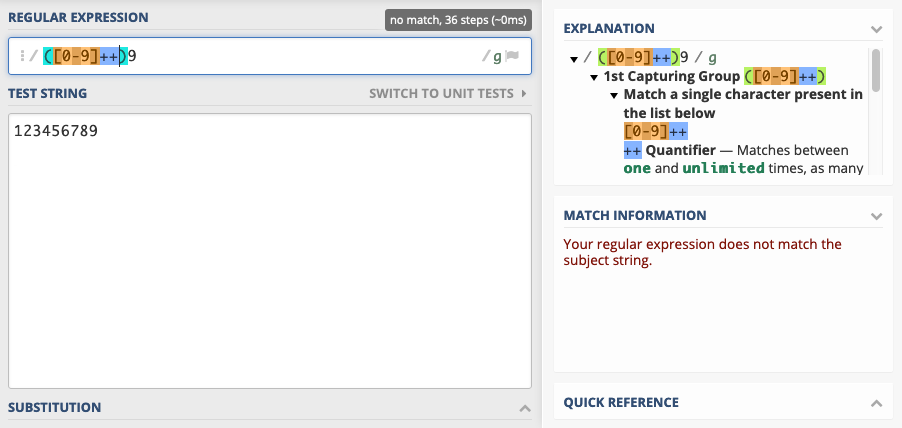
When would yous want possessive behaviour? When you know that you e'er want the longest conceivable match.
Let's say you lot want to extract the filename part of filesystem paths. Allow's assume / as the path separator. Then what nosotros effectively want is the last fleck of the string after the last occurrence of a /.
A possessive design works well here, because we e'er desire to consume all binder names before capturing the file name. There is no need for the part of the pattern consuming folder names to ever requite characters back. A corresponding pattern might look similar this:
\/?(?:[^\/]+\/)++(.*)
Note: using PHP
/regex/annotation hither, and so the forwards slashes are escaped.
We want to allow absolute paths, so we allow the input to start with an optional forward slash. We then possessively consume folder names consisting of a series of not-slash characters followed by a slash. I've used a non-capturing group for that — so it'southward notated as (?:pattern) instead of simply (pattern). Anything that is left over after the last slash is what nosotros capture into a group for extraction.
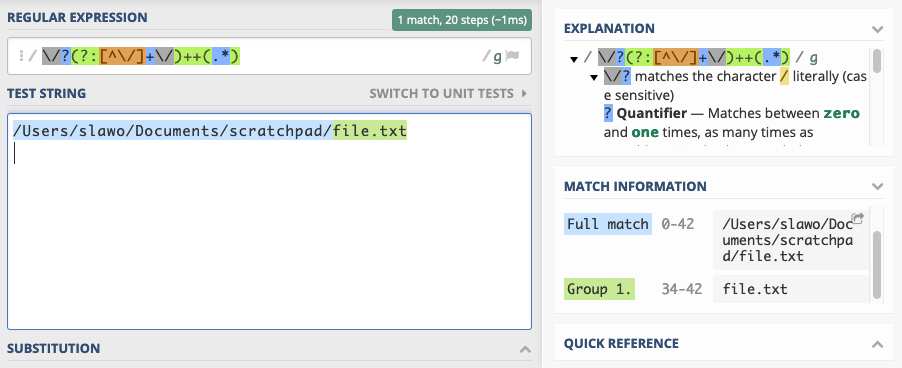
Non-Capturing Groups
Non-capturing groups match exactly the way normal groups do. Even so, they practice not make their matched content available. If in that location's no demand to capture the content, they tin can exist used to better matching performance. Non-capturing groups are written as: (?:blueprint)
Suppose we want to verify that a hex-cord is valid. Information technology needs to consist of an even number of hexadecimal digits each between 0–9 or a-f. The following expression does the job using a grouping:
([0-9a-f][0-9a-f])+
Since the point of the group in the pattern is to make sure that the digits come up in pairs, and the digits actually matched are not of any relevance, the group may simply equally well be replaced with the faster performing not-capturing group:
(?:[0-9a-f][0-9a-f])+
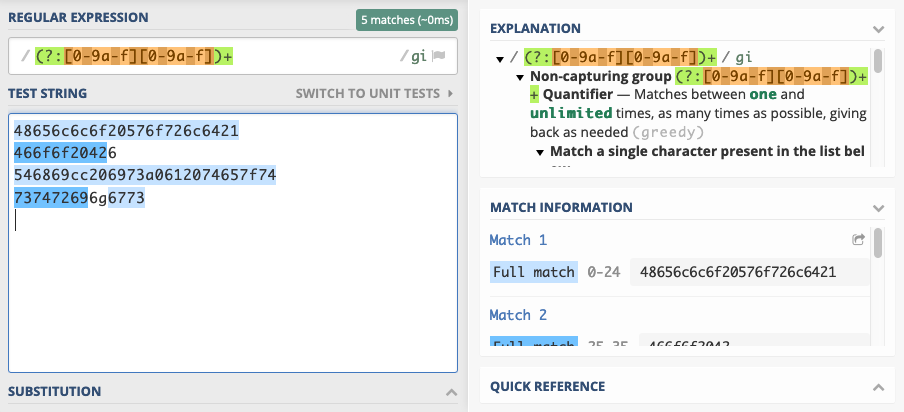
Atomic Groups
There is also a fast-performing version of a non-capturing group, that does not support backtracking. It is chosen the "independent not-capturing grouping" or "atomic grouping".
Information technology is written as (?>pattern)
An atomic group is a not-capturing group that tin can exist used to optimize design matching for speed. Typically it is supported past regex engines that also support possessive quantifiers.
Its behavior is also similar to possessive quantifiers: one time an atomic group has matched a part of the string, that first match is permanent. The group will never try to re-match in another fashion to adapt other parts of the pattern.
a(?>bc|b)c matches abcc but it does not match abc.
The diminutive group'due south first successful match is on bc and it stays that style. A normal group would re-match during backtracking to accommodate the c at the end of the pattern for a successful friction match. Just an atomic group's kickoff match is permanent, it won't change.
This is useful if you desire to friction match as fast as possible, and don't desire any backtracking to take place anyway.
Say nosotros're matching the file proper name office of a path. We can lucifer an atomic group of any characters followed past a slash. Then capture the balance:
(?>.*\/)(.*)
Note: using PHP
/regex/notation hither, so the forward slashes are escaped.
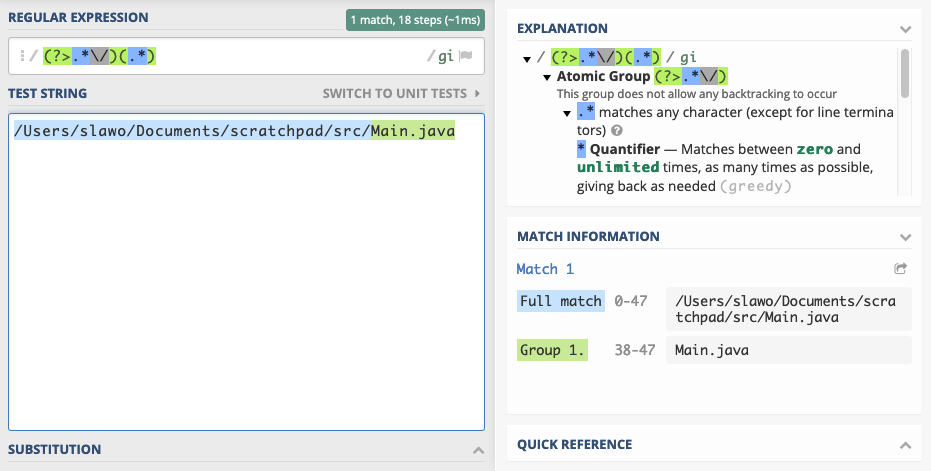
A normal group would have washed the job but also, but eliminating the possibility of backtracking improves operation. If you're matching millions of inputs against non-fiddling regex patterns, you'll start noticing the difference.
Information technology also improves resilience against malicious input designed to DoS-Assault a service by triggering catastrophic backtracking scenarios.
Back References
Sometimes it's useful to refer to something that matched earlier in the string. Suppose a string value is simply valid if it starts and ends with the same letter. The words "blastoff", "radar", "kick", "level" and "stars" are examples. Information technology is possible to capture function of a string in a group and refer to that group later on in the pattern pattern: a dorsum reference.
Back references in a regex pattern are notated using \due north syntax, where northward is the number of the capture grouping. The numbering is left to right starting with ane. If groups are nested, they are numbered in the gild their opening parenthesis is encountered. Group 0 always means the entire expression.
The post-obit design matches inputs that take at least three characters and get-go and cease with the aforementioned letter:
([a-zA-Z]).+\one
In words: an lower or upper case letter of the alphabet — that letter is captured into a grouping — followed by whatever non-empty cord, followed by the letter nosotros captured at the beginning of the friction match.
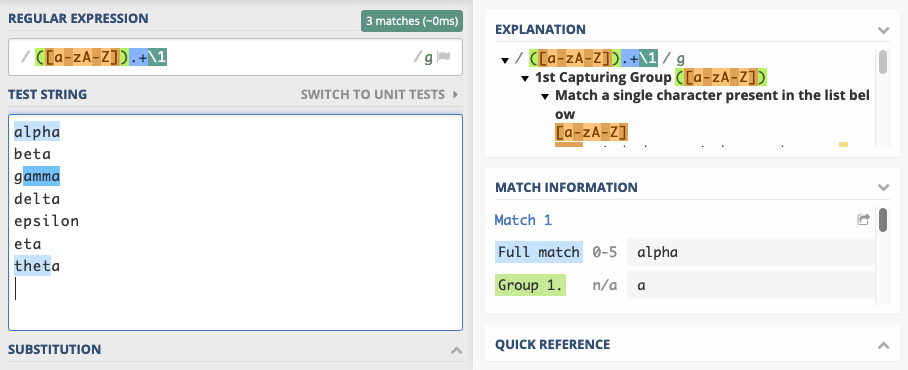
Permit'southward aggrandize a flake. An input string is matched if information technology contains any alphanumeric sequence — call back: word — more then in one case. Word boundaries are used to ensure that whole words are matched.
\b(\w+)\b.*\b\one\b
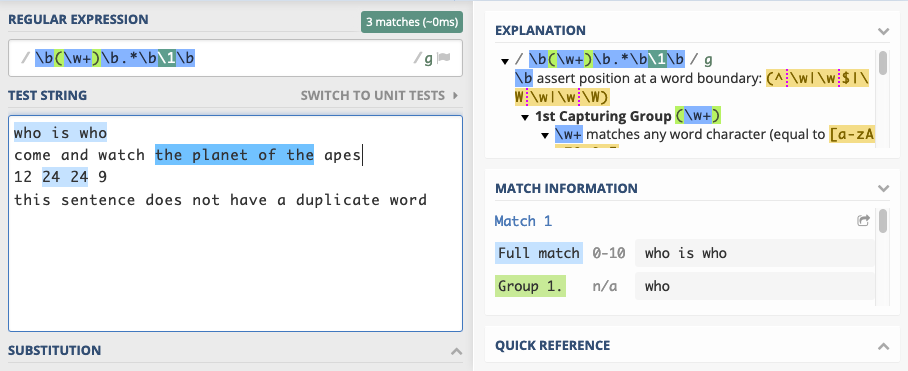
Search and Supercede with Back References
Regular expressions are useful in search and supplant operations. The typical use example is to look for a sub-cord that matches a pattern and supplant information technology with something else. Most APIs using regular expressions allow yous to reference capture groups from the search pattern in the replacement cord.
These back references finer let to rearrange parts of the input string.
Consider the following scenario: the input string contains an A-Z character prefix followed by an optional infinite followed by a 3–6 digit number. Strings like A321, B86562, F 8753, and L 287.
The task is to convert it to another string consisting of the number, followed by a dash, followed by the grapheme prefix.
Input Output
A321 321-A
B86562 86562-B
F 8753 8753-F
L 287 287-L The first step to transform one cord to the other is to capture each part of the string in a capture group. The search blueprint looks similar this:
([A-Z])\s?([0-9]{iii,6})
It captures the prefix into a group, allows for an optional infinite character, and so captures the digits into a second group. Back references in a replacement string are notated using $n syntax, where n is the number of the capture group. The replacement string for this operation should first reference the grouping containing the numbers, then a literal dash, and so the first grouping containing the letter prefix. This gives the post-obit replacement cord:
$2-$1
Thus A321 is matched by the search pattern, putting A into $1 and 312 into $2. The replacement cord is arranged to yield the desired event: The number comes beginning, then a nuance, then the letter prefix.
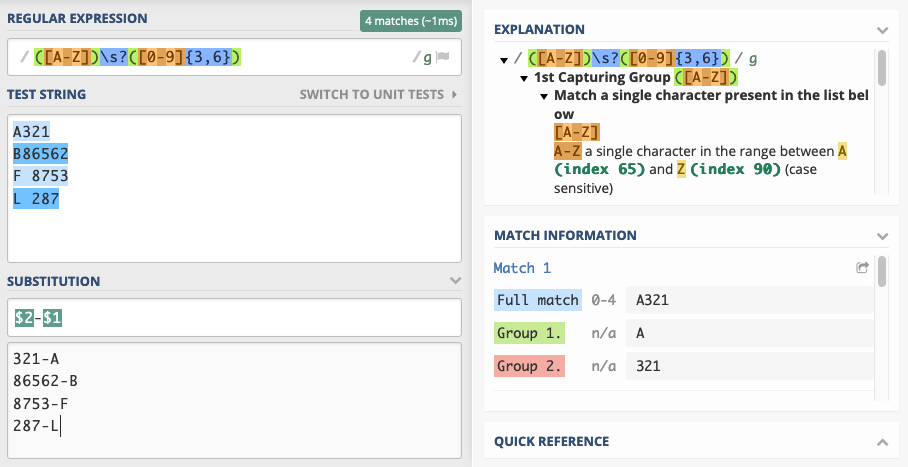
Delight note that, since the $ grapheme carries special meaning in a replacement string, information technology must exist escaped as $$ if information technology should exist inserted as a grapheme.
This kind of regex-enabled search and supersede is often offered by text editors. Suppose y'all have a list of paths in your editor, and the task at mitt is to prefix the file proper noun of each file with an underscore. The path /foo/bar/file.txt should become /foo/bar/_file.txt
With all we learned then far, we tin can practice it like this:
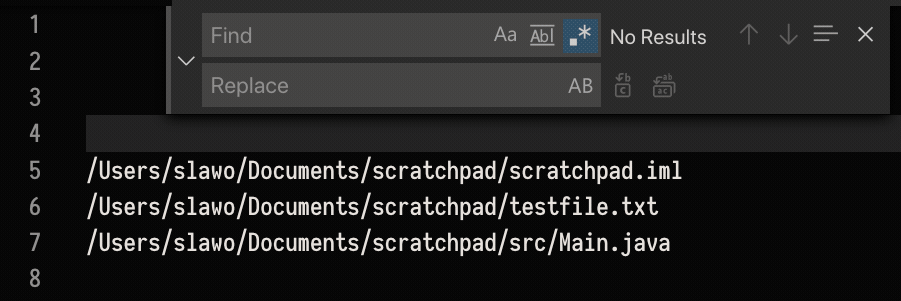
Expect, but don't affect: Lookahead and Lookbehind
Information technology is sometimes useful to affirm that a string has a sure construction, without actually matching it. How is that useful?
Let'southward write a blueprint that matches all words that are followed by a word beginning with an a
Let's try \b(\w+)\due south+a information technology anchors to a discussion boundary, and matches word characters until information technology sees some infinite followed by an a.
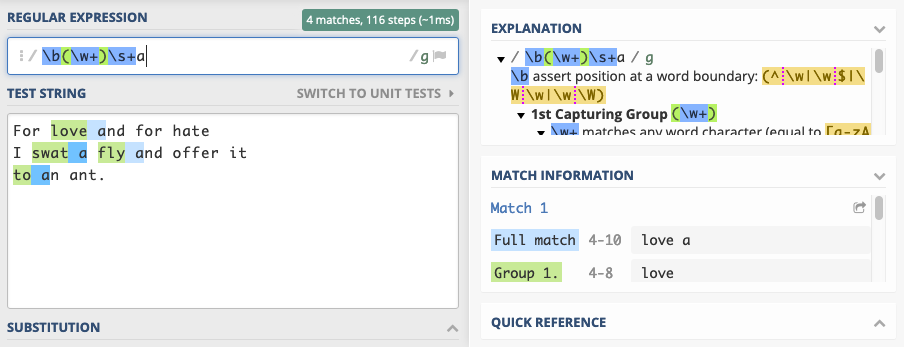
In the above case, we match love, swat, fly, and to, but neglect to capture the an earlier ant. This is because the a starting an has been consumed equally office of the match of to. Nosotros've scanned past that a, and the word an has no adventure of matching.
Would exist groovy if there was a way to assert properties of the beginning graphic symbol of the next word without really consuming it.
Constructs asserting existence, but not consuming the input are called "lookahead" and "lookbehind".
Lookahead
Lookaheads are used to affirm that a blueprint matches ahead. They are written every bit (?=design)
Let's apply it to fix our pattern:
\b(\w+)(?=\s+a)
We've put the space and initial a of the next word into a lookahead, then when scanning a string for matches, they are checked but not consumed.
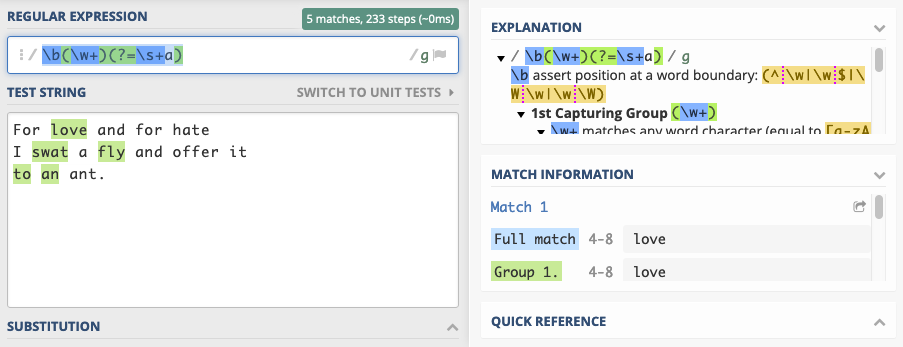
A negative lookahead asserts that its pattern does not match ahead. It is notated as (?!pattern)
Let's observe all words not followed by a discussion that starts with an a.
\b(\w+)\b(?!\due south+a)
Nosotros match whole words which are not followed by some infinite and an a.
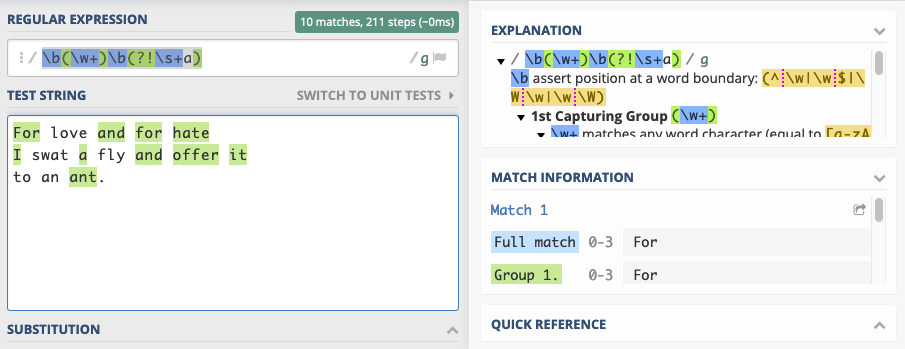
Lookbehind
The lookbehind serves the same purpose as the lookahead, but it applies to the left of the current position, non to the right. Many regex engines limit the kind of design you lot can apply in a lookbehind, because applying a pattern backwards is something that they are non optimized for. Check your docs!
A lookbehind is written every bit (?<=pattern)
It asserts the existence of something earlier the current position. Let's find all words that come after a word catastrophe with an r or t.
(?<=[rt]\southward)(\w+)
We assert that there is an r or t followed by a space, then we capture the sequence of discussion characters that follows.
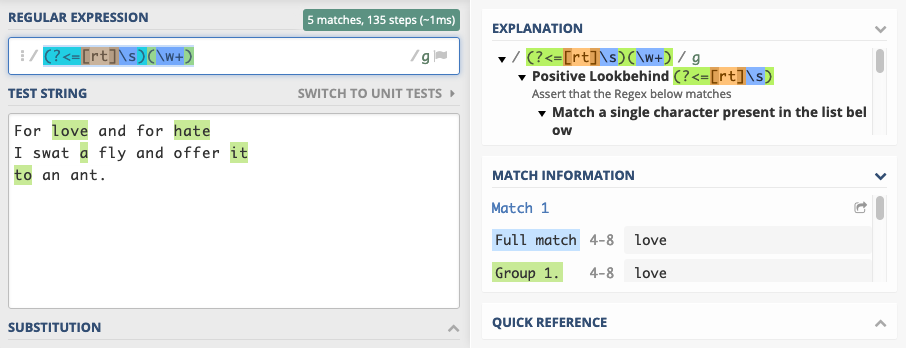
At that place's too a negative lookbehind asserting the non-being of a pattern to the left. Information technology is written every bit (?<!pattern)
Let's capsize the words found: We desire to match all words that come after words not ending with r or t.
(?<![rt]\due south)\b(\westward+)
Nosotros match all words by \b(\west+), and by prepending (?<![rt]\s) nosotros ensure that any words we match are non preceded past a word catastrophe in r or t.
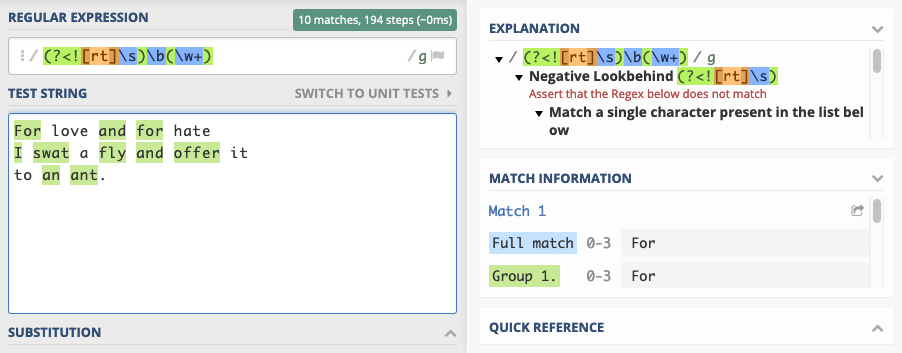
Divide patterns
If you're working with an API that allows you to separate a string past pattern, it is often useful to keep lookaheads and lookbehinds in mind.
A regex split typically uses the blueprint as a delimiter, and removes the delimiter from the parts. Putting lookahead or lookbehind sections in a delimiter makes it lucifer without removing the parts that were just looked at.
Suppose yous have a string delimited by :, in which some of the parts are labels consisting of alphabetic characters, and some are time stamps in the format HH:mm.
Allow's look at input cord time_a:9:23:time_b:x:11
If we just split on :, nosotros get the parts: [time_a, 9, 32, time_b, 10, 11]
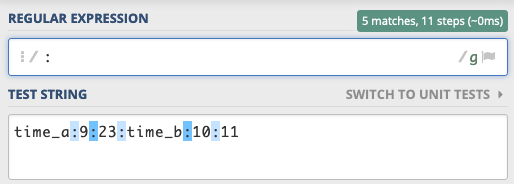
Permit'due south say we desire to improve by splitting but if the : has a letter on either side. The delimiter is at present [a-z]:|:[a-z]
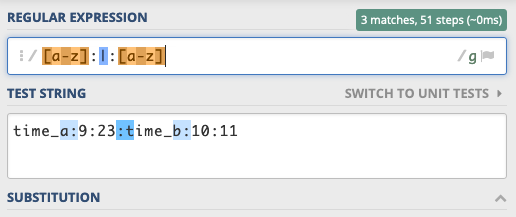
We go the parts: [time_, nine:32, ime_, 10:11] We've lost the side by side characters, since they were part of the delimiter.
If we refine the delimiter to use lookahead and lookbehind for the adjacent characters, their beingness will be verified, but they won't match every bit role of the delimiter: (?<[a-z]):|:(?=[a-z])

Finally we get the parts nosotros want: [time_a, 9:32, time_b, 10:11]
Regex Modifiers
Most regex engines allow setting flags or modifiers to tune aspects of the pattern matching process. Be certain to familiarise yourself with the style your engine of option handles such modifiers.
They frequently make the departure betwixt a impractically complex pattern and a trival one.
You lot tin await to notice case (in-)sensitivity modifiers, anchoring options, full match vs. patial match mode, and a dotAll way which lets the .graphic symbol class match annihilation including line terminators.
JavaScript, Python, Java, Ruby, .Cyberspace
Allow'south look at JavaScript, for example. If you desire case insensitive way and only the outset lucifer found, you can utilize the i modifier, and make certain to omit the g modifier.
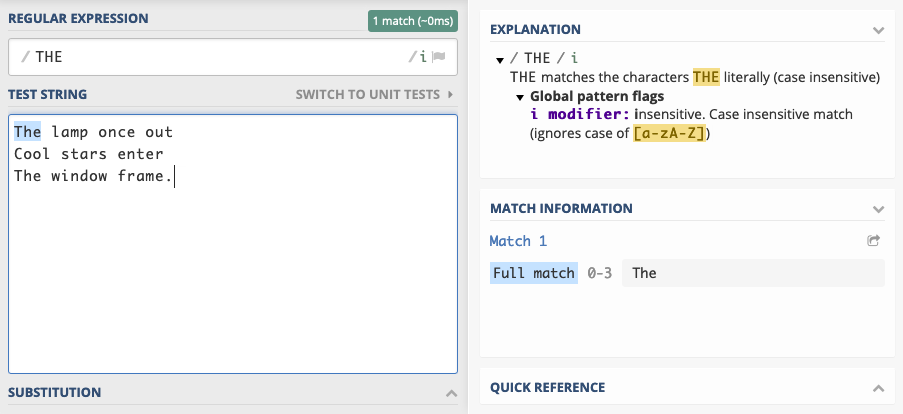
Limitations of Regular Expressions
Arriving at the finish of this article you may feel that all possible string parsing problems can be dealt with, once you go regular expressions under your belt.
Well, no.
This article introduces regular expressions as a shorthand notation for sets of strings. If you lot happen to have the exact regular expression for zip codes, you have a shorthand notation for the set of all strings representing valid zip codes. You can hands test an input cord to cheque if it is an element of that fix. There is a trouble yet.
There are many meaningful sets of strings for which there is no regular expression!
The set of valid JavaScript programs has no regex representation, for example. There will never be a regex pattern that can check if a JavaScript source is syntactically correct.
This is generally due to regex' inherent disability to deal with nested structures of arbitrary depth. Regular expressions are inherently non-recursive. XML and JSON are nested structures, and then is the source code of many programming languages. Palindromes are another example— words that read the aforementioned frontwards and backwards like racecar — are a very simple class of nested structure. Each character is opening or closing a nesting level.
You can construct patterns that will lucifer nested structures up to a certain depth but you can't write a blueprint that matches arbitrary depth nesting.
Nested structures often turn out to be non regular. If you lot're interested in ciphering theory and classifications of languages — that is, sets of strings — have a glimpse at the Chomsky Hiararchy, Formal Grammars and Formal Languages.
Know when to achieve for a different Hammer
Let me conclude with a discussion of caution. I sometimes encounter attempts trying to apply regular expressions non only for lexical analysis — the identification and extraction of tokens from a string — but likewise for semantic analysis trying to translate and validate each token's meaning likewise.
While lexical analysis is a perfectly valid utilize example for regular expressions, attempting semantic validation more oft than not leads towards creating another problem.
The plural of "regex" is "regrets"
Let me illustrate with an example.
Suppose a string shall be an IPv4 address in decimal annotation with dots separating the numbers. A regular expression should validate that an input string is indeed an IPv4 address. The first attempt may wait something like this:
([0-9]{1,3})\.([0-9]{1,3})\.([0-9]{ane,3})\.([0-9]{i,3})
It matches four groups of one to three digits separated by a dot. Some readers may feel that this pattern falls brusk. It matches 111.222.333.444 for example, which is not a valid IP address.
If you now experience the urge to change the pattern so information technology tests for each group of digits that the encoded number be between 0 and 255 — with possible leading zeros — then y'all're on your mode to creating the second problem, and regrets.
Trying to do that leads abroad from lexical assay — identifying four groups of digits — to a semantic assay verifying that the groups of digits translate to admissible numbers.
This yields a dramatically more complex regular expression, examples of which is found here. I'd recommend solving a problem similar this by capturing each group of digits using a regex pattern, then converting captured items to integers and validating their range in a separate logical step.
When working with regular expressions, the merchandise-off between complexity, maintainability, performance, and definiteness should always be a conscious decision. After all, a regex pattern is as "write-but" equally computing syntax tin get. It is hard to read regular expression patterns correctly, permit alone debug and extend them.
My advice is to comprehend them equally a powerful string processing tool, but to neither overestimate their possibilities, nor the ability of man beings to handle them.
When in doubt, consider reaching for some other hammer in the box.
Source: https://towardsdatascience.com/everything-you-need-to-know-about-regular-expressions-8f622fe10b03
0 Response to "How to Make Regular Expression Run Again"
Post a Comment